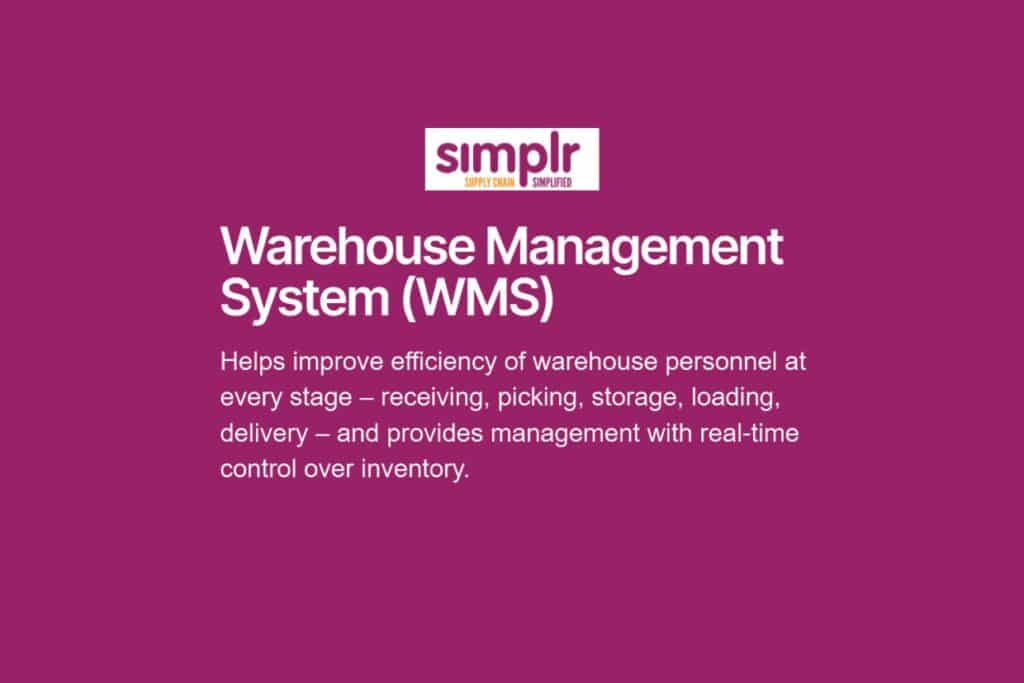At present, everything, including business, seems to be fast-paced, and so will it in the future. For a business to run smoothly, many conditions need to be met appropriately, and technologically two of the most important pieces that would make everything go at pace are the Warehouse Management System and Inventory Management System.
Now, don’t be baffled when it is mentioned as two separate identities. Yes, they are most often used interchangeably, yet it is not the same, even though they might have a few similarities with each other.
In this article, we will be discussing how these two systems are different and why it is not a prudent idea to use the two words interchangeably!
What is a Warehouse Management System?
A warehouse management system (WMS) is software that processes warehouse management operations that allow business organisations to control and administer the business processors.
In the year 2019, the warehouse system was valued at $4.16 billion, and by the year 2027, it is estimated that this will rise by $9.7 billion at a CAGR of 9.2%.
This involves tasks such as managing stock storage, picking, shipping, and order managing activities in a warehouse.
What is an Inventory Management System?

An Inventory Management System(IMS) is a software process which involves managing inventory and stocks throughout the entire entity of the supply chain beginning from the purchase of the products to the end sale.
The IMS is said to be reached an estimated value of $3.82 billion during the years 2021 to 2027 at a CAGR of 6.12%.
Additionally, this involves ordering and replenishment, tracking orders while helping to avoid stockouts and an excessive amount of stocks.
Inventory management system vs Warehouse management system
Let’s check how the inventory management system and warehouse management systems differ from one another,
1. Complexity
The primary difference between IMS and WMS lies in the level of complexity. IMS is considered to be less complex than a WMS due to the fact that a Warehouse management system manages all most all the processes in the warehouse while, on the other hand, IMS manages only inventory-related tasks.
A warehouse management system is primarily focused on the optimisation of warehouse operation processors, such as the transportation of goods inside and outside the warehouse facility, organisation of inventory and processors such as shipping and picking. In contrast, IMS focuses on inventory level tracking and management and is not highly complex as a warehouse management system.
2. Scope
The second foremostly visible difference between a warehouse management system is in regards to the scope of the system. A warehouse management system is designed to cope with a larger scope, while an inventory management system deals with a lesser scope compared to WMS.
For example, an IMS is designed specially to coordinate activities pertaining to inventory levels and managing them, as was mentioned a while ago. On the other hand, the warehouse management system is designed to coordinate inventory activities, regulation space, equipment, and orders, providing robust information and many other functionalities as well. Hence, the two systems can also be differentiated by their functionality.
3. Integration
When integration is considered, a warehouse management system tends to be fully integrated with other different systems to make it more convenient. It can include business processors such as Customer Resource Management systems(CRM), Enterprise Resource Planning(ERP), Material Resource Planning Systems (MRP) and much more.
Warehouse Management system has increased the productivity with integrated order processing systems by 25%, according to statistics by the year 2023.
In contrast to this, the inventory management system usually stands unaided without an integrated system since it is most specifically used for managing inventory levels only.
4. Control
When an inventory management system compels to know only the amount of stocks which means its quantity, whether it’s available or not, and whether it’s in the right quantity or not, a warehouse management system compels to show the location of the specific products as well. Thus, in this case, WMS will give you much more control in regard to business operations rather than an inventory management system.
5. Scalability
From the perspective of a Warehouse Management System, this has a broader scope than an Inventory Management System. While the WMS manages differential tasks such as receiving, storing, packaging, packing and shipping, an IMS only is limited to a few tasks.
Additionally, volume is another factor which follows up with scalability. The WMS system not only handles the number of products but also handles the transactions that occurred during specific times, unlike the IMS, which implies that the WMS has larger scalability than an IMS.
6. Time of implementation

Time is indeed valuable in terms of running a business, and if you are someone wondering about which system will be faster, we would probably leave it out to Inventory Management System.
A WMS implementation can take up to about 6-8 months to implement, while an IMS implementation will take only around 12-16 weeks(3- 4 months approximately).
Since the complexity and the scalability of a WMS are greater than IMS, it would be ideal to state it takes a lesser amount of time to implement an IMS rather than a WMS system as above.
7. User interface
The user interface of the two systems takes quite a turn in this factor as well. When the UI design is considered, the WMS is designed in a manner to optimise warehouse operations and other workflows, while the IMS is designed to manage inventory level tracking and stock management.
In terms of navigation, WMS have options to manage tasks and can navigate through different menu options; in contrast, IMS most often consists of searching and filtering options to manage the specific inventory tasks hassle-free.
8. Visibility
The IMS can aid visibility in regard to two processors:
Soft inventory allocation
Here, the system will reserve the required quantities of products in each node(e.g., warehouse) without concern about the specified warehouse location in which it is actually available in.
Available-To-Promise(ATP)
This refers to the inventory levels which a business can guarantee in regard to the level of inventory for future customer distribution. In this case, by calculating the ATP, it will be easier to monitor and analyse inventory more efficiently and minimise backorders and stockouts by fulfilling the needs of the customer.
On the other hand, WMS uses hard inventory allocation, which means the commitment between supply and demand cannot be changed and is reserved for a specific order from a specific location in the warehouse itself (e.g.pallet location for needed and specific pallet orders).
9. Tracking
Considering the differences between tracking the two systems, a warehouse management system involves tracking counts in individually in the related products and tracking each type of product in the warehouse.
In contrast, an inventory management system involves tracking units of space, compartments and bins and all other types of stocks within the warehouse.
10. Monetary perspective
When looking into the monetary perspective of the two systems, this can vary based on the size of the company, the features and complexity of the software and the functionalities which are required for the business to proceed.
Yet, generally, the integration of a Warehouse Management System is costlier than the implementation of an Inventory management System.
Approximately, WMS can cost about $1500 per month, while IMS can be $100 per month.
11. Training
When WMS training is considered, it is quite more complex than the training given for an IMS since the complexity, scalability, and scope are all much greater in the WMS system than in IMS.
Training in Warehouse Management systems typically focuses on the usage of features such as order fulfilment, inventory management and other related workflows.
In Inventory Management System, the training is based and focused on managing the inventory levels, creating inventory reports and monitoring stock levels.
Differences summarised based on the comparisons!
Feature | Warehouse Management System(WMS) | Inventory Management System(IMS) |
Complexity | High complexity | Low complexity comparatively to WMS
|
Scope | Has a high scope | Lesser scope comparatively to WMS
|
Integration | Often with integrated systems | Often Stands alone |
Control | Gives more control over the business operations | Lesser control comparatively to WMS |
Scalability | High scalability | Lesser scalability comparatively to WMS
|
Time of implementation | Requires a long time (6-8 months) | Requires a short time compared to WMS(3- 4 months |
User interface | Complex | Simpler comparatively to WMS |
Visibility | Most often hard inventory allocation | Most often soft inventory allocation |
Tracking | tracking counts in individually in the related products | involves tracking units of space and all other types of stocks in the warehouse |
Monetary perspective | High-cost | Low-cost comparatively to WMS |
Training | Complex training | Less complex comparatively to WMS |
Now, you might wonder how the two words are used interchangeably if it has a considerable number of differences. Not letting you be confused, hence, will discuss a few similarities between the two systems as well.
Similarities between the warehouse management system and Inventory management system
Here are 3 similarities between the two systems:
1. Inventory Management
Both of these systems can be used to manage inventory.
WMS can be used to manage inventory within the warehouse, and IMS can be used to manage inventory across many locations, which includes the whole supply chain system(e.g., warehouse, retail locations)
2. Radio Frequency Identification Devices(RFID) and barcode tools
Both the Warehouse Management System and Inventory Management System use RFID and barcode tools which aid in tracking and identifying real-time inventory.
This gives the possibility to enhance the accuracy and efficiency of the related work.
3. Visibility
Both of these systems provide visibility, basically into all stocks or either for a single warehouse facility or to the entire business.
This, too, contributes to making the work efficient, flexible and much more accurate.
How do you choose between Warehouse Management System and Inventory Management System?

When you are on the verge of thinking about upgrading your business, you might have come across WMS and IMS and might have been perplexed about what you need to choose or what will be the best for your company.
Here are a few questions to think about before you get into a decision…
1. How complex is the inventory sector of your business?
In this case, if it seems like your inventory is limited and pretty straightforward, you can consider going to an IMS.If not, if it seems like it is complex and inventory is distributed in various locations, consider WMS.
2. Are you dealing with a high amount of order volume?
And if the answer is yes, again, you can consider a Warehouse Management System.
3. How much will you be willing to keep aside for the new integration?
Above all, another vital aspect to consider is your company budget. You definitely don’t want to be bankrupt due to the integration, do you? That being the case, and if cost is currently the concern, even if you want to upgrade the business, try out Inventory Management System to begin with since it is lower in cost than WMS.
4. Will you be receiving the required features from the system you are about to integrate?
Note that all products related to WMS and IMS, which are either less costly or costlier, can be of no use if the features that you require are lacking.Therefore ensure that you are concerned about the features along with the prices.
5. Will you be able to integrate with other systems with ease?
Last but not least, it is crucial to check whether the WMS or IMS which you are about to be purchased can be integrated with other required systems easily and hassle-free.
Wind up
Ultimately, we hope this article gives an in-depth knowledge of the differences between the Warehouse Management System and Inventory Management system and contributes to your library as an asset which you were in need of!
Still, if you are lost, get in touch with Simplr, and we will do it for you!



